
The Japanese huge hornet is a close relative of the common hornet that lives in our country. But, despite this, the difference in appearance and size between these insects is simply huge.
Comparing them, you can see that the Japanese hornet differs from its European counterpart in color, however, this is far from its main characteristic feature. Dimensions - that's what this giant can "boast". This insect bears its name “giant Japanese hornet” for a reason: its body length can exceed 4 cm, and its wingspan is 6 cm.
The photo below shows a Japanese hornet (Vespa mandarina japonica):
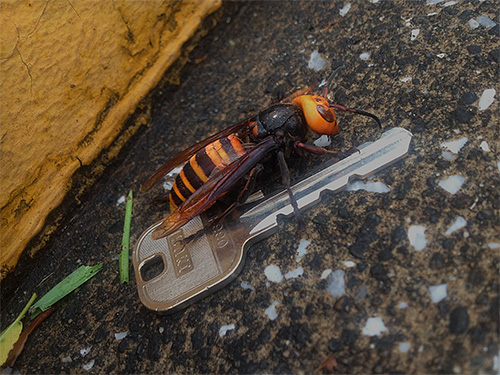
And this is how the common hornet (Vespa crabro), which is widespread in Russia and Europe, looks like:
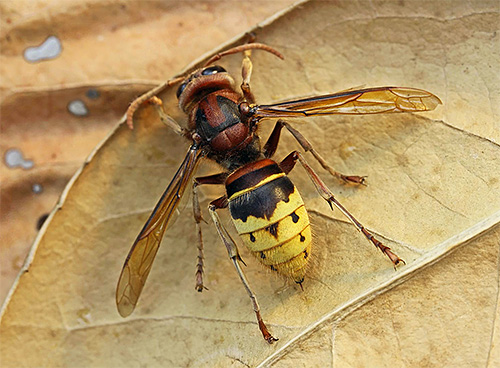
Perhaps the first thing that comes to mind when you see a Japanese “monster” is how dangerous it is and how painful its bite is. Indeed, the giant hornet has a very frightening appearance, which, however, accurately reflects the seriousness of the consequences of meeting him.
Japanese hornets can indeed be very dangerous: in the country that gave the name to these insects, more than 40 people die from their bites every year. All the people whom this hornet has ever stung claim that they have never experienced a more painful bite in their life.

On a note
Almost any meeting with a hornet, no matter what species it belongs to, is more or less dangerous. It is not surprising that medical scientists and biologists were very interested in the effect of the bites of these insects on the human body. It turned out that in nature one of the strongest is the poison that the giant Japanese hornet possesses: even with a single bite, it can cause a powerful allergic reaction, up to anaphylactic shock. With a massive attack by several hornets of this species, severe hemorrhages and tissue necrosis can occur in humans.

When planning a trip to Japan, it's a good idea to always be prepared for a chance encounter with giant hornets and know not only what they look like, but also how to behave so that the insects don't attack.
What does a Japanese giant hornet look like?
Generally speaking, the giant hornets in Japan are a subspecies of the giant Asian hornet. These insects are found only on the Japanese islands, being classic endemics.
Despite its impressive size, the giant Japanese hornet is still somewhat inferior in this respect to the mainland scoli wasps: these insects are even larger. The scolia is considered the largest wasp in the world.
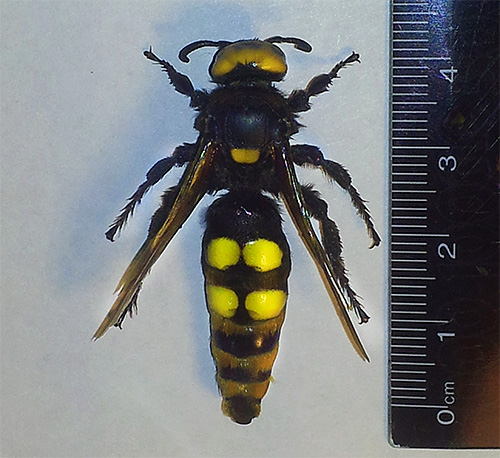
However, the Japanese hornet is not small either (especially in comparison with other species) - in the photo below you can estimate its size compared to a human palm:

The length and wingspan of the Japanese giant hornet is its main difference from most other species of the Hornet genus. Even compared to those of them that have a similar color, the Japanese giant is more striking due to the simple ratio of body dimensions to the size of flowers and branches on which it is found.

The coloration of the Japanese giant hornet is another of its characteristic features.The insect has a black chest, a yellow head and the base of the abdomen of the same color, which is lined with transverse brown and black stripes from the middle. Such a pattern makes it easy to distinguish this huge wasp from the European hornets familiar to us - in the domestic species, the back half of the abdomen is monotonously yellow.
Close-up photo of the Japanese hornet:
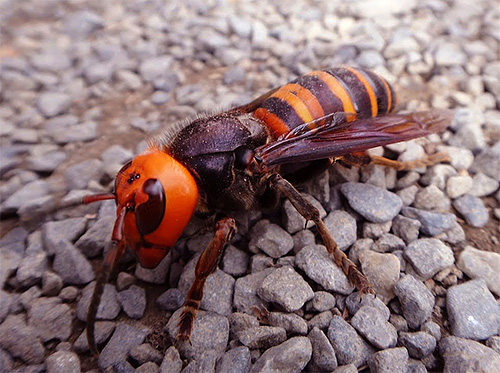
And for comparison, a photo of an ordinary hornet:
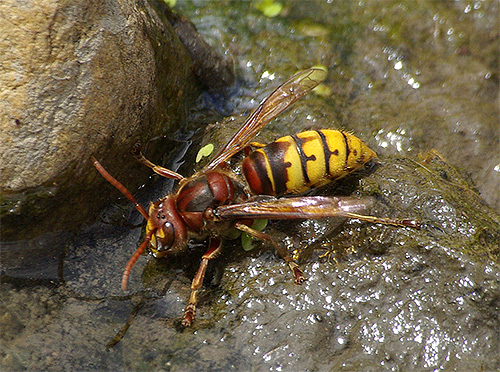
The giant hornet has two clearly visible large eyes on the front of the head, and a little higher than them - three additional small adnexal eyes that provide a large viewing area (see photo).
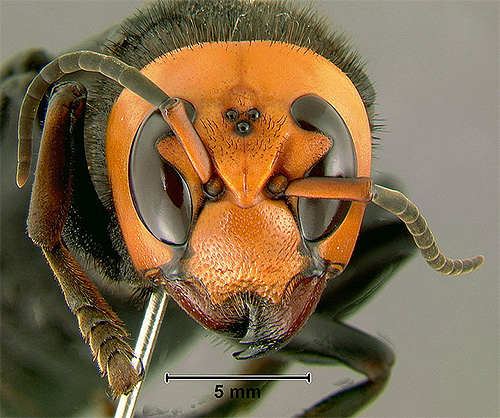
In general, all the hornets in the world - both European and Japanese, and the beautiful yellow Vespa bicolor - despite some distinctive features, are equally related and belong to the family of real wasps. For this reason, their lifestyle, diet and biology are very similar.
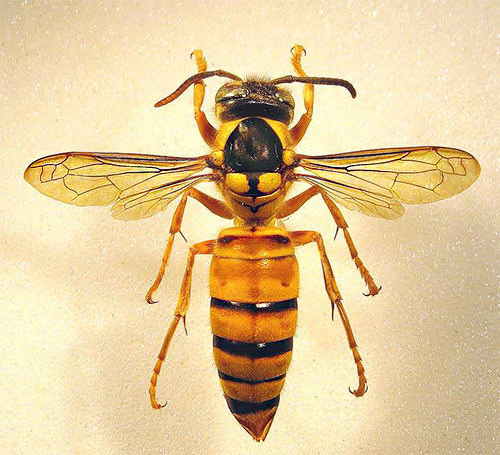
On a note
Sometimes the Japanese hornet is incorrectly called oriental. In fact, the eastern hornet (Vespa orientalis) is a separate species, common, for example, in southern Europe, in the subtropical regions of Asia, as well as in North Africa, and adapted to living in a dry climate. These insects nest in the ground.
Below is a photograph of an oriental hornet (Vespa orientalis):
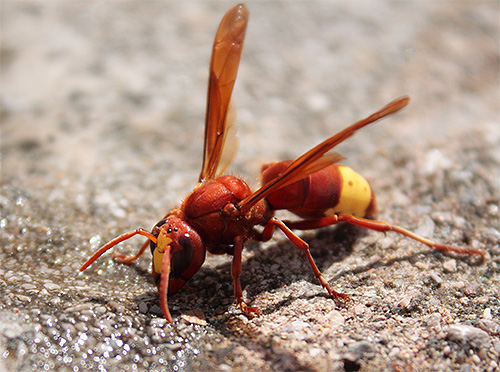
The life of a giant wasp
As already mentioned, the Japanese huge hornet is a strict island endemic. Outside of Japan, it was found only in the south of Sakhalin. On the mainland, this species is not found at all.
As for the way of life, the Japanese giant lives in almost all biotopes, except for the alpine belt and large cities.Where insects live, there are almost no drafts and other disturbing factors: their nests are located on the branches and in hollows of trees, under the roofs of rural buildings, on ledges of rocks in the forest zone, in stone cracks and natural niches.
A huge hornet builds dwellings that are very similar to paper nests of wasps, only larger and more voluminous. Such a structure and location of the dwellings of these insects is also characteristic of almost all other species of their relatives.
The nest is built by a young overwintered female in early spring. She feeds the first larvae herself, and the working hornets that have emerged from them begin to help the founding female to get food and care for the brood. After a short time - as the colony grows - the uterus stops doing anything other than laying eggs.

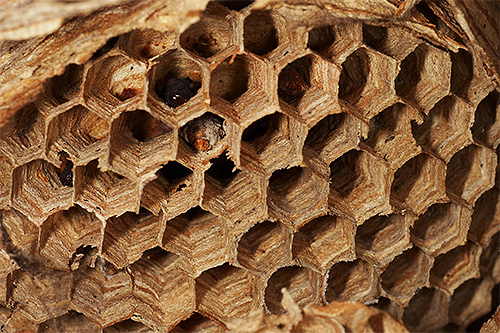
From the moment the egg is laid to the hornet leaving the pupa, about 28-30 days pass.
If we talk about the food habits of this insect, it is worth noting that the Japanese giant hornet, however, like all its close relatives, is a predator. The main part of its diet is made up of various insects, spiders, worms, and mollusks.
However, like other wasps, the huge hornet is very fond of honey, the juice of sweet fruits, and can also fly to the smell of meat and fish. He does not refuse even the products that have begun to deteriorate.
Another thing is the larvae. Hornets feed their offspring exclusively with meat of the highest quality - they give them the most tidbits of prey.
The photo below shows the larvae of the Japanese hornet:
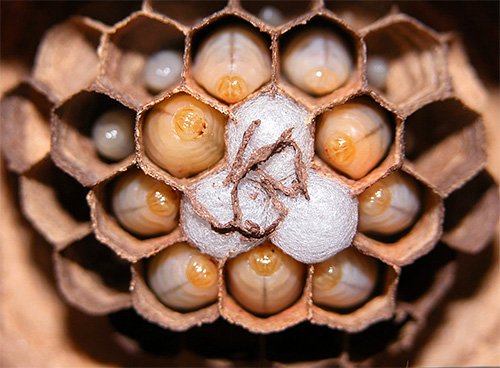
The entire colony of hornets develops until the swarming period, which occurs in late summer and early autumn. By this time, young males and females capable of breeding are hatched from the eggs.After swarming and mating, the males die, and the females find wintering shelters and hide in them in order to start the life cycle again at the beginning of summer.
Thus, the whole life of the hornets fits into just a short time period - the warm season. For the winter, the nest dies out, and only females remain from the entire family of many thousands.
The photo shows an example of such an empty nest:
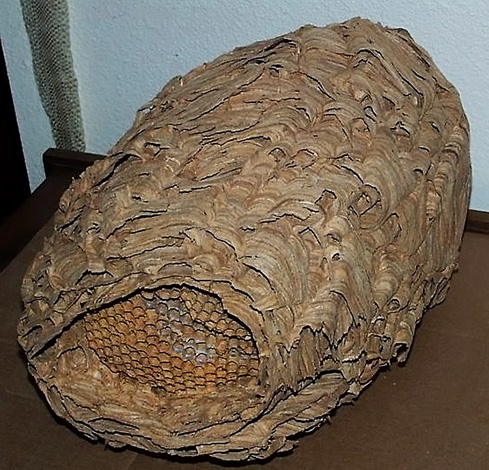
Thunderstorm of all bees
The huge hornet delivers the most trouble to Japanese beekeepers. Honey bees (usually European varieties, more industrious and less aggressive) are a real delicacy for hornets. However, not only bees are prey, but also the honey they produce, which the giant predator regales on after the destruction of the hive.

It is interesting
A single giant hornet can kill up to thirty bees in a minute, and a group of 30-40 "aggressors" destroys a bee family of 20-25 thousand individuals in a few hours.
If a scout hornet finds a residential hive with bees, it leaves odorous marks near it, and upon returning to the nest, it shows its fellows the way to a delicacy. After that, the killer hornets are already a whole detachment sent to ruin the hive.

In fairness, it is worth noting that some species of bees, in turn, also have a unique mechanism for fighting hornets. However, it gives results only with a small number of attackers. If the hornets attack in significant numbers, the bees, alas, are powerless.
So how does the bee defense mechanism work? The defense of the hive consists of several stages:
- at the very beginning, when a giant hornet tries to enter the hive, several bees surround it;
- further - others sit on them, and so on until a huge ball of bees grows around the hornet, up to 30-35 cm in diameter;
- in parallel to this process, all the defenders of the hive actively move their wings, directing the air inside the ball - to the aggressor - and heating it to 46-47 ° C, which are detrimental to the hornet (the bees themselves can withstand heating up to 50 ° C).

The result of all these efforts is the death of the attacking predator from overheating within about one hour.
Despite such a seemingly effective mechanism, bees are not able to cope with a whole detachment of winged killers. That is why the Japanese huge hornet is considered the cause of serious losses for beekeeping farms in this country. Apiary owners and workers are doing their best to destroy hornet nests near honey beehives.
Nevertheless, the fight of beekeepers against an insect enemy often ends in a loss: due to its size, a huge hornet can fly up to 10 km from its nest in search of food, and pursue the victim itself up to 5 km. Therefore, despite all the efforts of man, the destruction of the nests of a giant predator often does not give pronounced results in the protection of apiaries.
How venomous is the giant hornet?
The Japanese huge hornet is one of the most poisonous among its relatives. And the point here is not only in the toxicity and specificity of the poison, but in the amount that the insect can “reward” its victim: one serving of toxins in a huge Japanese hornet is almost one and a half times more than its ordinary European counterpart.
It is worth paying attention to the fact that, with all its toxicity, a huge hornet hunts mainly with the help of jaws. Sting and poison are used only when fighting the largest and most dangerous victims, when the giant is “not sure” of his strength, or when he is defending himself.
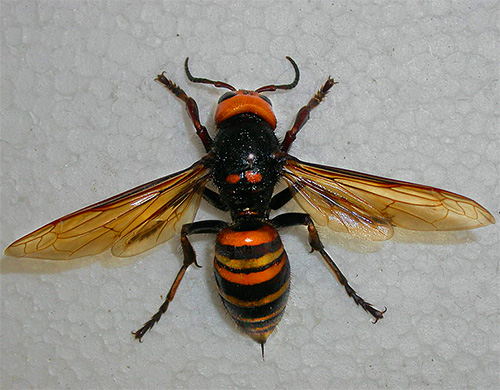
Interestingly, an ordinary honey bee, when bitten, introduces much more poison into the wound than even a hornet. At the same time, she often leaves her sting at the bite site, connected to a special reservoir with poison, the muscles of which continue to contract for a long time. The hornet never leaves its sting in the wound (its sting is not jagged, unlike the sting of a bee).
The photo below shows the sting of a bee:
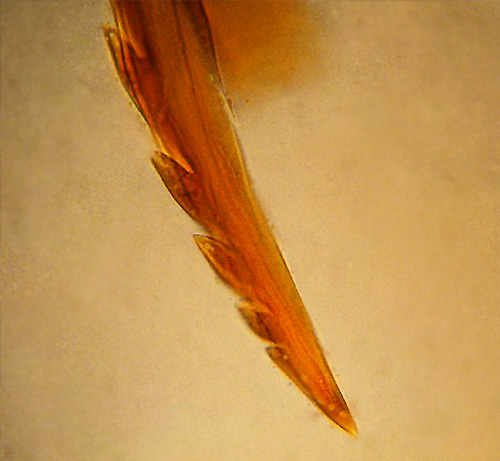
And this is what a hornet's sting looks like:
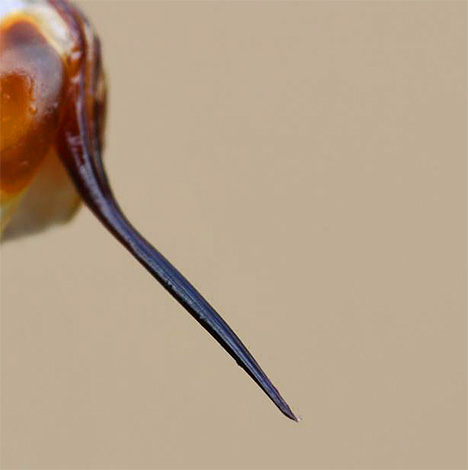
The bite of a huge Japanese hornet is really amazingly painful. It is felt immediately, as soon as the giant introduced the sting under the skin. Usually, within a few seconds after that, swelling, severe throbbing pain and inflammation appear at the site of the bite.

After about half an hour, more distinct and serious symptoms of poisoning develop - dizziness, heart palpitations, a sharp increase in body temperature. That is why a stung person needs careful observation - in some cases, these manifestations of allergies can almost instantly develop into a threat to life.
It is interesting
The length of the sting of the Japanese giant hornet is more than 6 mm. To introduce it under the skin, an insect does not have to land on a person, it can do it on the fly, and more than once.
In people who are especially sensitive to insect poisons, a seemingly banal edema can turn into a severe allergic reaction with an increase in lymph nodes, nausea and Quincke's edema.
Quite often, after such bites, the victims experience anaphylactic shock, sometimes with a fatal outcome. If a person is stinged by several hornets at once, he may develop a huge edema with profuse hemorrhages and necrosis of part of the tissues in the affected areas of the body.
Review
“The hornet bit me for the first time in the early summer of 2011 when I was working in my garden. The pain was terrible, as if molten lead had been doused on my palm. I shook the hornet off my hand and tried to suck the venom out of the wound, but to no avail. I had to go to the hospital. By the time I got to her, my condition had deteriorated greatly. The whole arm was swollen up to the elbow, I began to throw in a fever, my heart was pounding. Already in the hospital, some fast-acting drugs were introduced to me, and I began to feel better. Two days later, I was already discharged home, and my arm stopped hurting only after 12 days.
Isimi Thomas, Seema
Despite all the horrors that threatens the bite of a giant Japanese hornet, in general, it is much less aggressive and more calm than, say, an ordinary wasp or bee. It is the person who almost always provokes the bite of this huge predator - when he deliberately tries to get to the nest or accidentally touches the insect. In all other cases, giant hornets in Japan do not pose a direct threat to humans, and when meeting with them, you can easily disperse without consequences.
Interesting video: bees protect their hive from hornet invasion


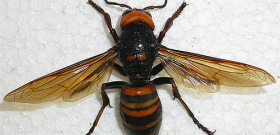

In the Primorsky Territory, they were brought a long time ago on ships ... Personally, in Nakhodka, he defended two beehives from nine robbers. They killed the bees, it's scary to remember.